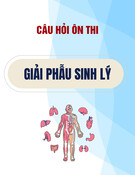
Bệnh viện Trung ương Huế
26 Journal of Clinical Medicine - Hue Central Hospital - Volume 17, number 2 - 2025
Factors related to dependencies among older patients with Parkinson’s disease
Received: 12/01/2025. Revised: 20/02/2025. Accepted: 17/3/2025.
Corresponding author: Tran Viet Luc. Email: tranvietluc@hmu.edu.vn. Phone: 0912532456
DOI: 10.38103/jcmhch.17.2.4 Original research
FACTORS RELATED TO DEPENDENCIES AMONG OLDER PATIENTS WITH
PARKINSON’S DISEASE
Tran Viet Luc1,2, Nguyen Thi Thu Huong2,3, Vu Thi Thanh Huyen2,3
1Department of Neurology, Hanoi Medical University, Hanoi, Vietnam
2National Geriatric Hospital, Hanoi, Vietnam
3Department of Geriatrics, Hanoi Medical University, Hanoi, Vietnam
ABSTRACT
Background: Patients with Parkinson’s disease experience physical decline due to the disease’s relentless
progression, which may cause them unable to perform activity daily living. This study aimed to explore some factors
related to ADL and IADL dependencies among older people with Parkinson’s disease.
Methods: This cross-sectional study conducted on 190 older patients who were diagnosed with Parkinson’s disease
were being examined and treated at the National Geriatric Hospital from March to October 2023. Activities of Daily Living
(ADL) was assessed using the Katz Index, Instrumental activities daily living (IADL) was assessed using the Lawton IADL.
Results: The rates of ADL and IADL dependence were 51.1% and 61.1%, respectively. Multivariate logistic
regression analysis showed independent factors associated with an increased risk of ADL dependence were: stage of
Parkinson’s disease 3-5 (OR 3.47), Parkinson’s disease duration (OR 1.10), symptom of rigidity (OR 2.96), cognitive
impairment (OR 5.18) and upper limb strength impairment (OR 2.83). Some factors independently associated with an
increased risk of IADL dependence were: osteoporosis (OR 11.25), stage of Parkinson 3-5 (OR 5.44), Parkinson’s
disease duration (OR 1.13), cognitive impairment (OR 3.74) and upper limb strength impairment (OR 4.54).
Conclusions: Stage 3-5 PD, longer disease duration, cognitive impairment, and upper limb weakness independently
increase ADL/IADL dependence in older adults with PD. However, since this study was cross-sectional, this association
should be interpreted with caution. Targeted interventions may help mitigate these risks.
Keywords: Dependence, Parkinson’s disease, older adults, related factor.
I. INTRODUCTION
Parkinson’s disease (PD) is a neurodegenerative
disorder of the brain, which is the second most
prevalent after Alzheimer’s diseases [1]. Over 8.5
million people worldwide are estimated to have
PD, which is more prevalent in older people and
typically manifests after the age of 50. The global
prevalence of PD has doubled over the past 25 years
[2]. According to the latest WHO data published in
2020, Parkinson’s disease deaths in Vietnam reached
0.78% of total deaths [3]. Parkinson’s disease has
motor symptoms that negatively affect balance,
quality of life, activities of daily living (ADL), and
instrumental activities of daily living (IADL) [4].
Most people with Parkinson’s disease experience
physical decline as a result of the disease’s
relentless progression, which may cause them
to lose the ability to perform ADL, especially in
later stages [5]. This creates a burden on both the
patient and the caregiver. In addition to affecting the
performance of daily activities, many studies have
found PD-related limitations in a variety of IADL
even relatively early in the course of the disease,
including driving, managing finances, managing
medications, shopping, and household management.
IADL limitations are linked to lower quality of life
and disengagement from daily activities in patients
with PD [6].








































